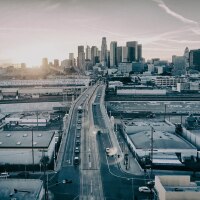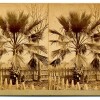
The Curiously Magical Air of Los Angeles
Illustrations by Vera Valentine
“Elemental L.A.” is an exploration of an Angeleno “sense of place” using the four classical elements — air, earth, water, and fire — as guides.
The air of Los Angeles has always been a contentious, turbulent, and magical territory. Artists, filmmakers, writers, environmentalists, and scientists have found both inspiration and conflict in its thickness, its refractions, its particulates, and luminosities.Berenika Boberska, “(What is) the Nature of Los Angeles”
Bahía de los Humos
In early October 1542, looking across a plain that rose to a line of hills that paralleled the course of his three ships, Juan Rodríguez Cabrillo first saw the Los Angeles basin. What he remembered after — what became his logbook entry — was the layer of haze suspended over the plain. As his ships tacked northwest against the persistent onshore wind, Cabrillo named the place he was leaving the Bahía de los Humos — Bay of Smokes. The one element that defined this place for its first European observer was in the air of Los Angeles.
Four hundred years later, Anglo occupiers of the plain speculated that the cooking fires of Indigenous communities or their deliberate burning of the dry autumn grass caused the persistent haze. But perhaps Cabrillo only saw the marine layer that lingers in the coastal air.
Cabrillo came seeking golden myths — the Amazon island, Cibola's seven cities, a Northwest Passage to the Atlantic — none of which was under the thermal inversion that would brew photochemical smog one day. Cabrillo brought nothing to Los Angeles except dreams. They've been as durable as the inversion layer.

Sanitarium of the Union
Once, the air of Los Angeles was magical. "Vegetation dries up before it dies, and hardly ever seems to decay. Meat suspended in the air dries up, but never rots," wrote Benjamin Truman in "Semi-Tropical California" (1874). "The air, when inhaled, gives to the individual a stimulus and vital force which only an atmosphere so pure can ever communicate." So pure that lightning and thunder were unknown.
This air — with the advice of a physician — could cure specific complaints, doctors Widney, Orme and Lasher pointed out in their 1874 report to the city's business leaders. Malaria sufferers were advised to live at the beach. Asthmatics would find the air of the local tar pits or the mountain pines beneficial. Cases of "nervous prostration" would be healed by an outdoor life (which also would remedy bladder and kidney troubles and the effects of arthritis and rheumatism).
Los Angeles at the end of the nineteenth century was so much "the sanitarium of the Union" that the foothills above Glendale and around Sierra Madre and Altadena were crowded with sanitariums, and the Chamber of Commerce worried that Los Angeles had become the place where invalids waited to die in the pure air and perpetual sun.
Jasmine, Honeysuckle, Wildfire
Information is in the air. The unseen wildfire in a foothill arroyo reveals itself in the oils vaporized by the burning chaparral: aromatic sage and creosote, woody manzanita and chamise. Suburban rewilding is reported by the mercaptan stink — rank but bracing — of an agitated skunk. If the light, honeyed scent of jacaranda follows you, it must be April. And when the blossoms have fallen in drifts a few weeks later, they have an earthy, loamy scent. Summer is the smell of jasmine: pink, star and night blooming so heady that it can drive you indoors on warm evenings.
Early spring used to smell of orange blossoms, a sweetness that promised more than Los Angeles delivered. February mornings smelled of crude oil that had burned all night in smudge pots to keep the oranges from freezing.
Chandler Burr, writing for GQ magazine, says Los Angeles smells like a blend of eucalyptus, jasmine, diesel exhaust and asphalt. Honeysuckle should be added to the mix, as well as brine and kelp when the marine layer reaches inland. The smell of Los Angeles, Burr says, is "like the jolt of a drug."
A company called Homesick makes scented candles that are supposed to evoke specific places. Their Los Angeles scent is orange, bergamot and rose with notes of lemon, jasmine and musk.
Pandemonium
What's that sound? It's the voice of the trafficked, of migrants transported from Tamaulipas and San Luis Potosí. It's the sound of a pandemonium of parrots. Escapees from bird smugglers or (some say) from a burning pet shop, the parrots have been here since the 1960s. The mitred parakeets of Belmont Shore and the red-crowned parrots of South Pasadena are the most fully naturalized. A flash of green as if scraps of jungle had appeared among the jacaranda blooms. Sociable squabbling fills the air.

Cities have a characteristic soundscape. Sprawling Los Angeles has a symphony of them. Not just non-native birds in non-native trees, but classic Motown from a Harley stopped at a red light, the rumble and hiss of surf against a Malibu beach, the unexpected loudness of tires on asphalt just after rain, the ominous rustle of eucalyptus leaves in October, the surveilling drone of another police helicopter.
Ethnomusicologist Umi Hsu of LA Listens and neighborhood organizer Shmueli Gonzales are walking down Cesar Chavez Boulevard in Boyle Heights, and what they hear is revealing. Hsu hears "sporadic rattling sounds of objects loosely positioned on the back of a metal collector truck, construction workers blasting and singing along to ranchera ballads while renovating residential properties, all against the constant humming of high-speed traffic on Interstate Highway 5. These sounds tell…a bit about the livelihood of the informal metal recycling business, the recent economic development in the neighborhood that threatens displacement for some residents, and the memory of the multiethnic neighborhoods demolished by highway construction in the 1950s."
Gonzales tells her that chain retailers around Mariachi Plaza are in a "volume war" with the mariachis who solicit gigs with their street corner playing. Hsu and Gonzales pass a hired DJ blaring techno in front of a wireless store. It's the sound of gentrification, Gonzales says.
Carbon Monoxide, Nitric Oxide, Ozone
What goes up in the air of Los Angeles stays there, says Richard Flagan, Caltech atmospheric scientist. Dust, pollen, water vapor, chemical aerosols and products of their interaction hang over the city, trapped beneath the thermal inversion. Bright sun, remarkably still air, and the barrier of nearby mountains likely brewed the haze that Cabrillo called smoke and Angelenos today breathe uneasily as smog. But it's not the smog of seventy years ago. Then, it was so opaque that it forced the closure of LAX, so eye and lung-searing that it kept children idle at their school desks at noontime.
Smog has changed, and Angelenos saw the mountains more often in 2020 as a result. But ozone (an invisible, reactive gas) reached dangerous levels on 157 bad air days. Particles of soot from engine exhaust continued to settle in the lungs of children living downwind of freeway interchanges. Breathing autumn's wildfire smoke settled even more. Indoor air isn't much better. Particulate levels in many Los Angeles homes can be as much as 70% of the polluted outside air.
But the hydrocarbon sunsets of Los Angeles — with colors from urine to scarlet to dried blood — they blaze!
Tiny Moons
The air of Los Angeles performs a magic trick. The mountains that ring the basin can be made to disappear, sometimes in just a few minutes. The still air of the basin — the same stillness that worsens smog — suspends particles of granite eroded from those mountains. This finely divided stuff is precisely the right size to interact with the wavelength of daylight. The light is reflected back at the observer as if from billions of tiny moons, each about half a micron in diameter. The reflected light (which includes light scattered from clouds and the land surface) produces the illusion that something is occulting the mountains. But it's not a material screen like fog or haze, but light itself. It's the airlight of Los Angeles.

Airlight reduces contrast. Enough reduction in contrast and objects in view disappear into the featureless luminosity reflected from those billions of tiny moons. The artist Robert Irwin told the New Yorker's Lawrence Weschler that Los Angeles becomes almost shadowless in its airlight. "Broad daylight — and in fact lots and lots of light — but no shadows. Really peculiar, almost dreamlike…."
Air holds one answer to the apparent insubstantiality of Los Angeles. Or as the architect Coy Howard noted to Weschler, in this "diaphanous soup" Angelenos find a "magic-meditative sense of presence." We breathe illusions here.
Further Exploration
The restorative power of the air of Los Angeles, as reported in 1874, is included in "The History of the Medical Profession in Southern California" (Times-Mirror, 1910) by George H. Kress and Walter Lindley. Available online
Chip Jacobs, co-author of "Smogtown: The Lung-Burning History of Pollution in Los Angeles," (Abrams Press, 2008) told smog's story in an ALOUD podcast from the Los Angeles Public Library.
Environmental Health and Justice in Southern California, a UC Riverside student research project, combines pollution data, maps, and memories to tell the stories of those who are affected by air, water, and soil pollution.
Lawrence Weschler's essay on the light in Los Angeles appeared in The New Yorker in 1998. He revisited its themes in a New Yorker video from 2016.





